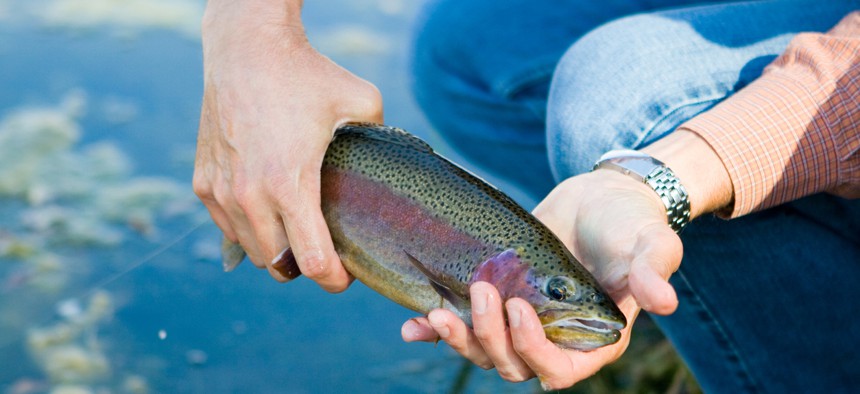In One State, Fish Populations Take Flight

istockphoto.com/rhyman007
The Utah Division of Wildlife Resources drops thousands of fish from airplanes into lakes to maintain populations in high-altitude, hard-to-reach areas. Almost all of them survive.
The video starts with gentle music and footage from a camera attached to the underside of a plane, coasting between a clear blue sky and a blanket of green pine trees. Four seconds in, the aircraft moves over a sparkling lake. There’s a dramatic drumbeat, the music intensifies and the footage switches to slow motion as a spray of water—and thousands of fish—drop from the belly of the plane, their bodies scattering into the lake below.
It looks dramatic—and traumatic—but most of the fish will be fine; that is, in fact, the entire point of the drop, according to the Utah Division of Wildlife Resources, which posted the clip to social media earlier this month. The process, known as “aerial fish stocking,” is used to shore up fish populations in roughly 300 high-elevation lakes that aren’t accessible by more traditional means.
“The fish are between 1-3 inches long, so they flutter down slowly to the water,” the agency wrote on Facebook. “Aerial fish stocking in Utah is an effective method of stocking and has been since the mid-1950s. Post-stocking netting surveys show that survival of aerial-stocked fish is incredibly high.”

Traditionally, state wildlife agencies stock fish populations by tanker truck, hauling specific species from place to place on highways and roads and then sliding them into the water via a detachable chute. Utah does that for some of its lakes, but for high-elevation lakes without nearby roadways, more creative means are necessary, said Matt McKell, a biologist with the state agency.
“Back in the early days of ‘off-road’ fish stocking, horses were loaded with metal milk cans filled with water and fish, and then packed to remote areas,” he wrote in a 2017 blog post. “By the 1950s, small airplanes became the preferred method for stocking fish into backcountry lakes, which is actually still the case today.”
The agency uses a two-person, single-engine aircraft equipped with a seven-chamber tank that can carry up to 84 pounds of fish—or 35,000 individual swimmers—at a time, allowing for restocking of multiple lakes in a single flight. The plane travels between 70 and 80 miles per hour, depending on the weather, and drops fish from just above the treeline—usually between 50 and 150 feet above the water, said Faith Heaton Jolley, a spokeswoman for the Utah Division of Wildlife Resources.
“There are often cliffs, mountains, tall trees and other obstacles that determine how low the pilot can fly,” she said. “The safety of the pilot and passenger is a key consideration.”

Biologists prep the fish for flight by withholding food for a day or two to empty their digestive tracts in an effort to reduce the amount of feces they expel. Too much poop fouls the water and reduces the amount of oxygen in the tank, stressing the fish, said Randy Oplinger, the agency's sportfish coordinator.
"We add oxygen to the tank to help fight this, but it tends to get too low when there is a lot of fecal material," he said. "Also, it turns out that the feces contains chemicals that are toxic to fish."
Those toxins are diluted naturally or broken down by organic material in larger habitats like lakes and rivers, Oplinger said. But in a tank, where fish are packed more tightly together, the toxins can reach lethal levels more quickly.
"Of course we don't want our fish to be hangry," Oplinger said. "But hangry is better than dead."
Only small fish known as “fingerlings” are used for drops, Jolley said. Their diminutive size—usually between 1 and 3 inches long—slows their descent, which helps ensure their survival. Up to 95% of them live through the fall, the agency said, and the sound of their bodies hitting the water has been described by onlookers “as being similar to rain.”
The method may be unusual, but fish stocking is common practice for wildlife agencies across the country as part of long-term management plans that seek to maintain population levels of native species and regulate the balance of predator and prey in waterways. In Utah, that means frequent stocking of cutthroat trout, a species native to the state, as well as non-native fish like brook trout and Arctic grayling. Those specimens are usually sterile, preventing them from reproducing and overwhelming the ecosystem, Jolley said.
“This helps us control their numbers and minimize their impact on the native fish populations in that waterbody,” she said. “These other species are not stocked into waters where they could potentially impact native fish. We stock these waters to provide an opportunity for anglers to catch fish in a beautiful, often secluded location.”
Kate Elizabeth Queram is a senior reporter for Route Fifty and is based in Washington, D.C.

NEXT STORY: The Time Tax





